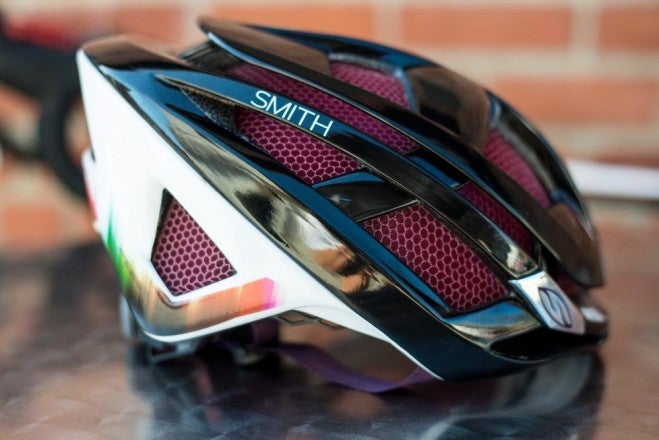Smith Designs New Road Helmet With Women In Mind

The Overtake is available in November and retails for $250. Smith also offers an optional MIPS liner. Photo: Jen See | VeloNews.com
This November, Smith Optics is releasing their first road helmet, the Overtake, which boasts a unique, lightweight design. With the Overtake and the coordinating Pivlock sunglass line, Smith is hoping to appeal not only to men but also to the growing number of women who are passionate about road cycling.
Though the Overtake is not specifically a women’s product, Smith has designed their new flagship helmet with women in mind. The Overtake is offered in 12 color choices, so there is something to fit every rider’s style. The Overtake also includes a dial fit system that is easy to adjust and works similarly to most helmets on the market. And yes, the Overtake’s fit system does include an opening for a ponytail (my massive mop of hair fit without a problem).
Pick up the Overtake and the most noticeable feature is the light weight and the translucent honeycomb material that forms the exterior. The unique material, Koroyd, is a co-polymer sometimes used as the core material for skis and snowboards.
The material is lightweight, translucent, and breathable. Smith claims the Overtake weighs 250 grams, which is comparable to the published weight of the new Giro Synthe. The Koroyd acts as the Overtake’s ventilation system; the Overtake boasts 21 vents which are filled with the material. We have yet to test the Overtake in truly hot weather, but it is comfortable in California’s moderate fall temperatures.
According to Smith, the Koroyd also adds to the overall strength of the helmet. The honeycomb texture is created through thermal welding, and under impact, the Koroyd crumples to absorb the energy of a crash.
“Koroyd absorbs up to 30 percent more energy from an impact when tested to international standards,” Smith product manager Graham Sours told Velonews by email.
The Overtake is built like a layer cake. Smith calls this their “Aerocore” construction. The first layer is a polycarbonate (PC) shell, with Koroyd panels inlaid in the place of the more familiar open-air vents. A traditional EPS liner sits over the PC shell and Koroyd panels. In the next layer, a thermo-formed skeleton provides additional strength. An external PC shell sits over it all.
According to Smith’s in-house aerodynamic data, the Overtake tests 1.06 seconds slower than the Specialized Evade over 40 kilometers, but 4.15 seconds faster than the Giro Air Attack.
The Overtake is also designed to be worn with an optional MIPS (Multidirectional Impact Protection System) liner. Initially adopted by ski racers, MIPS is now increasingly popular in cycling.
While a traditional helmet protects against linear forces—a direct impact to the head—MIPS aims to combat the rotational forces on the brain that may come from a crash. When a helmet hits the ground or other surface at an angle, it can cause a twisting motion, which can increase injuries to the brain.
The MIPS liner allows the helmet to slide slightly on the head. This small movement helps defuse some of the torsional forces on the brain.
The concept is similar to how the human head is engineered. Inside the skull, a layer of fluid separates the brain from the bone that protects it. This fluid allows the brain to move slightly within the skull and protects it from injury.
The addition of the MIPS liner reduces the ventilation of the Overtake, and the liner adds a slight amount of weight, but for some riders, the increased safety will be worth these trade-offs. The MIPS-equipped Overtake is available in five colors.
Read more and view more photos: Velonews.com